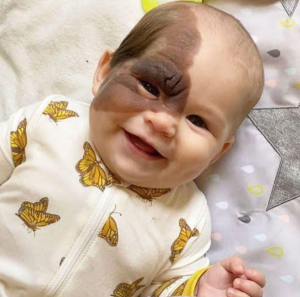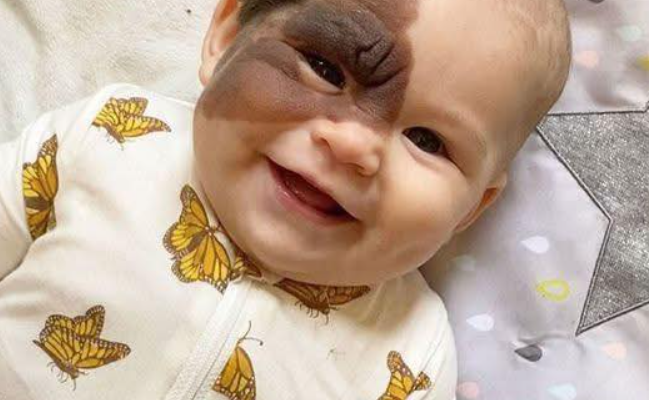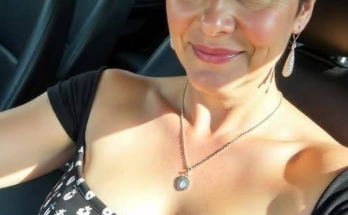Marked by Love: The Story of Vienna’s Birthmark and Her Parents’ Brave Choice
In the quiet hours after her daughter Vienna Brookshaw was born in April 2021, British mother Celine Casey found herself staring at the tiny face nestled in her arms. Between Vienna’s eyebrows was a distinct birthmark—a congenital melanocytic nevus (CMN), a benign cluster of pigment cells that had formed in utero. It posed no medical threat. But for Casey, it was more than a mark. It was a question. A future. A mirror of how the world might treat her daughter.
From the beginning, Casey and her partner were captivated by Vienna’s beauty. They adored her completely, birthmark and all. But as Vienna grew, Casey began to notice something unsettling. Strangers stared. Some hesitated. Others asked questions. And Vienna, still a baby, seemed to sense the difference. She would grow quiet, uneasy, her eyes searching her mother’s face for reassurance.
It wasn’t vanity that drove Casey to consider removing the birthmark. It was empathy. It was the deep, intuitive understanding that children absorb the world’s reactions long before they can articulate their own. “We cherish every moment of Vienna’s journey,” Casey said, “and eagerly await the day she can express her own thoughts. With or without a birthmark, we would always and forever love her”.
But love, in this case, meant action.
The Emotional Weight of a Mark
Congenital melanocytic nevus is rare, and while medically harmless, it can carry a heavy emotional toll. Children with visible differences often face subtle forms of exclusion—curious glances, whispered comments, or the quiet cruelty of being “othered.” Casey feared that Vienna, once she entered school, would be treated differently. That she would internalize the stares. That she might one day resent her parents for not doing something when they could.
The National Health Service (NHS) declined their initial request for removal, deeming the procedure cosmetic rather than essential. But Casey didn’t give up. She saw the emotional landscape ahead and knew it was worth fighting for.
She launched a crowdfunding campaign, explaining Vienna’s story with honesty and vulnerability. The response was overwhelming. In just one day, they raised $52,000. But due to rising hospital costs during the COVID-19 pandemic, they needed an additional $27,000. Undeterred, they returned to GoFundMe, driven by the belief that Vienna deserved the chance to grow up without the burden of unwanted attention.
Surgery, Scars, and Healing
Vienna underwent three surgeries. Each one was a step toward healing—not just physically, but emotionally. Today, she is a healthy two-year-old with a small scar on her forehead. Her parents continue to monitor her recovery, even traveling to London to ensure the scar is healing properly. They’ve been meticulous, protective, and deeply loving.
Casey shares updates with her supporters, often praising Vienna’s resilience and beauty. “Everyone has insecurities about their body,” she wrote. “Even though the doctor told us it wouldn’t currently damage Vienna’s mental health, we saw it differently. Little ones notice these things because they are perceptive, especially when they start school at age three”.
This wasn’t about erasing Vienna’s uniqueness. It was about giving her the freedom to define herself—without the weight of others’ perceptions.
The Psychology of Perception
Vienna’s story touches on something deeper than cosmetic surgery. It’s about how we perceive difference, how children internalize social cues, and how parents navigate the emotional terrain of raising a child in a world that often values conformity.
For Casey, the birthmark was a symbol—not of imperfection, but of vulnerability. She understood that Vienna might one day embrace it, or she might struggle with it. Either way, Casey wanted to give her daughter the choice. And that meant removing the mark before Vienna was old enough to feel its emotional impact.
This decision wasn’t universally praised. Some questioned the need for surgery. Others worried about setting a precedent for altering a child’s appearance. But Casey’s response was grounded in love and psychological insight. She wasn’t trying to “fix” Vienna. She was trying to protect her.
A Communal Story
What makes Vienna’s journey so powerful is the communal support it inspired. Thousands of strangers donated, commented, and shared her story. They saw in Vienna a reflection of their own children, their own fears, their own hopes. The crowdfunding campaign became more than a fundraiser—it became a ritual of collective care.
Vienna’s scar is now a quiet reminder of that love. It’s not hidden. It’s not erased. It’s simply part of her story—a story shaped by empathy, courage, and the belief that every child deserves to feel safe in their own skin.
Looking Forward
As Vienna grows, she’ll learn about the choices her parents made. She’ll see the photos, read the updates, and perhaps one day ask why. And Casey will tell her: “Because we love you. Because we saw the world through your eyes before you could speak. Because we wanted you to walk into every room without hesitation.”
Vienna’s future is unwritten. She may become an artist, a scientist, a storyteller. She may embrace her scar as a badge of resilience. Or she may forget it entirely. What matters is that she was given the chance to choose.
Final Reflections
In a world where appearance often shapes experience, Vienna’s story is a reminder that love is not passive. It’s active. It’s perceptive. It’s willing to challenge systems, raise funds, and face criticism—all for the sake of a child’s emotional well-being.
Celine Casey didn’t remove Vienna’s birthmark to make her daughter more beautiful. She did it to make her feel free. And in doing so, she gave Vienna a gift that goes far beyond skin: the gift of being seen, understood, and cherished.


